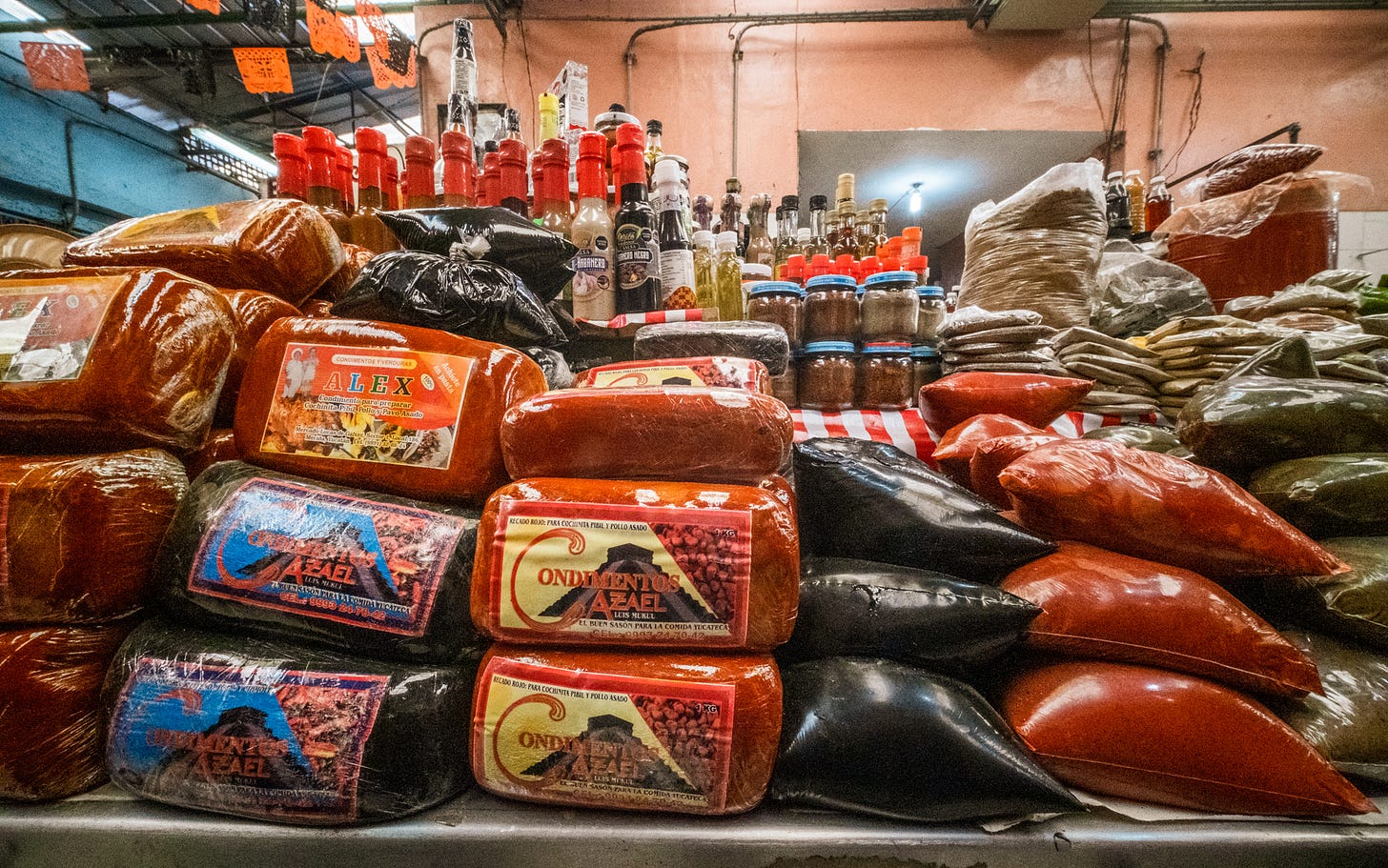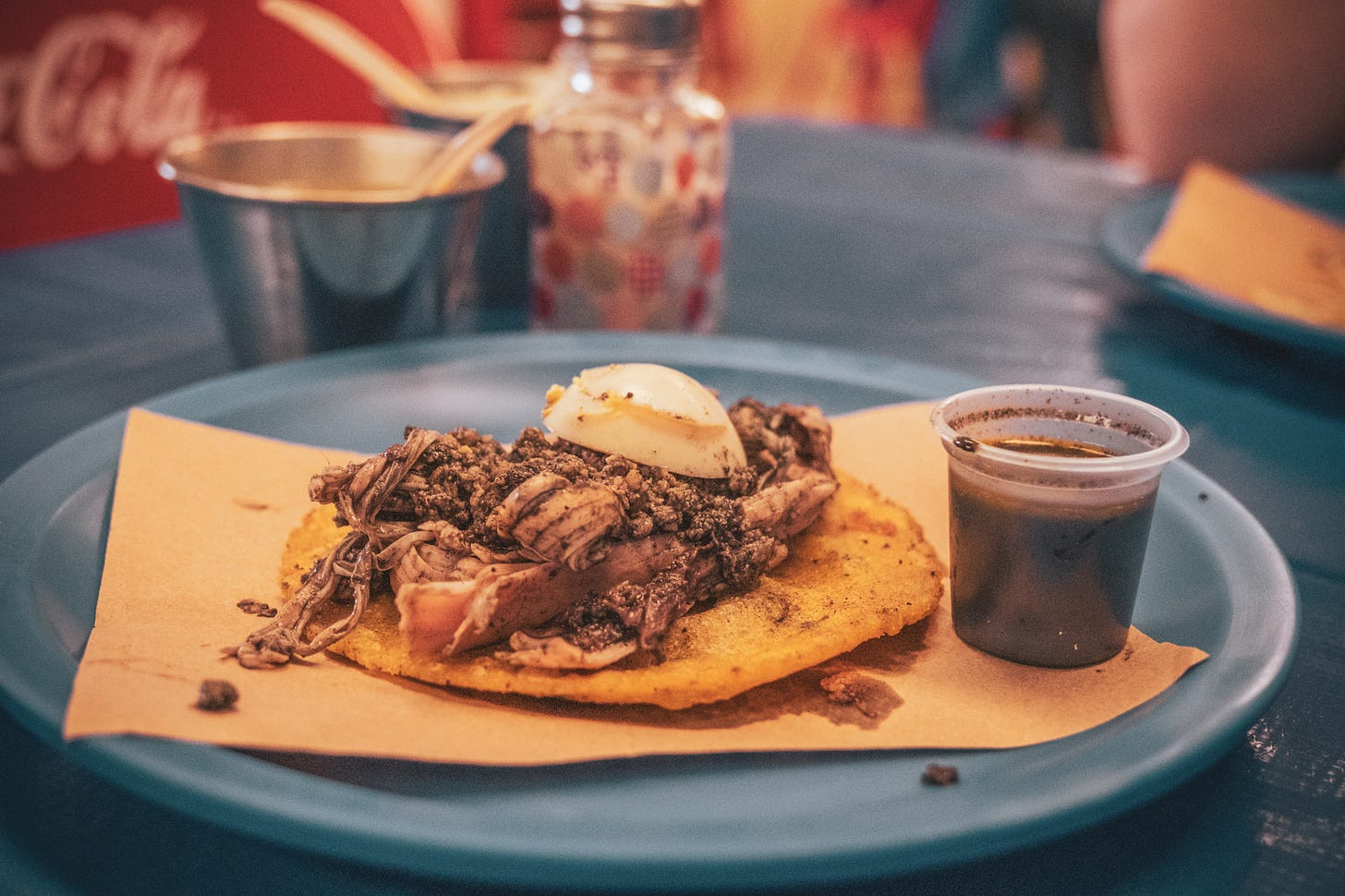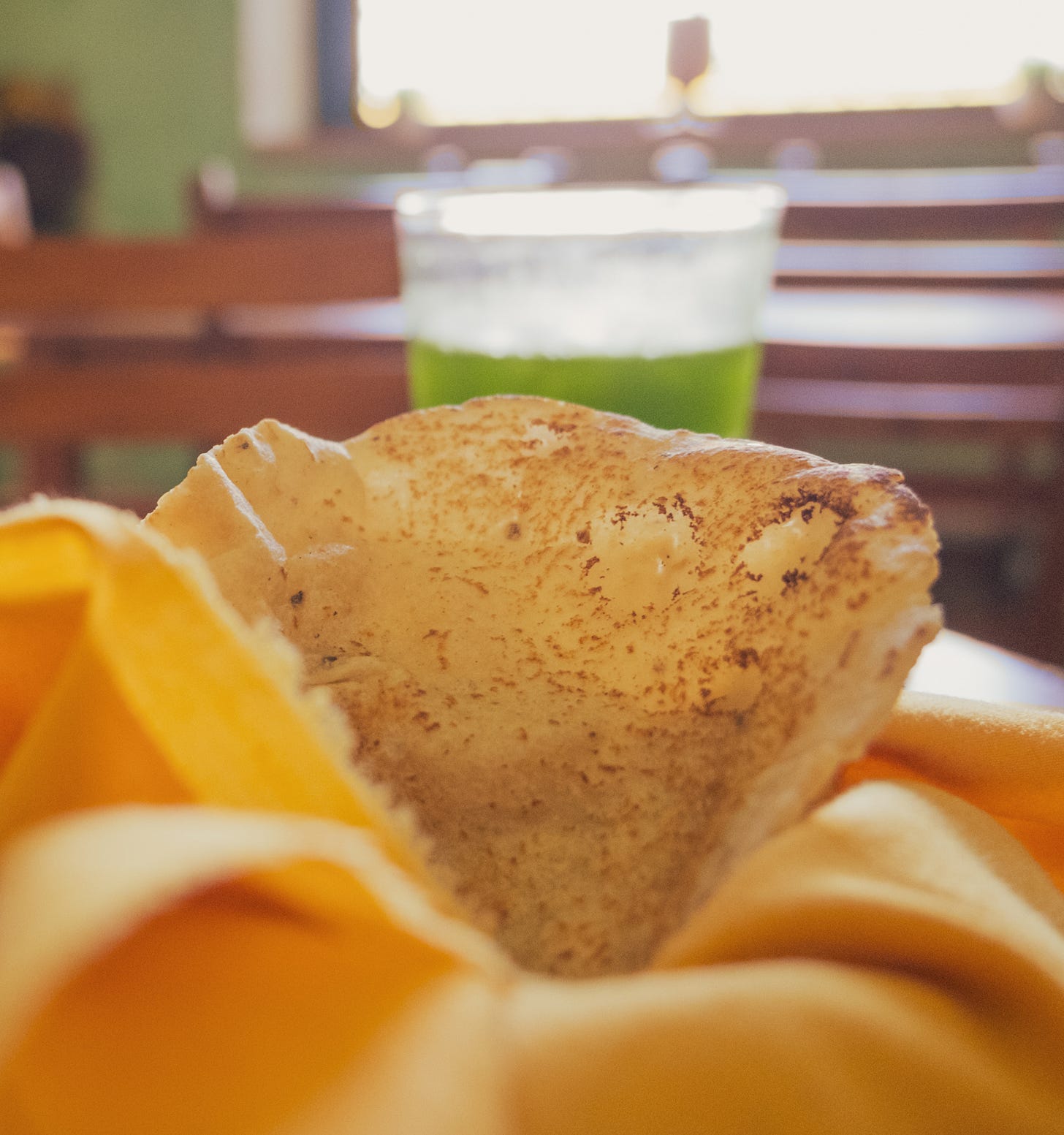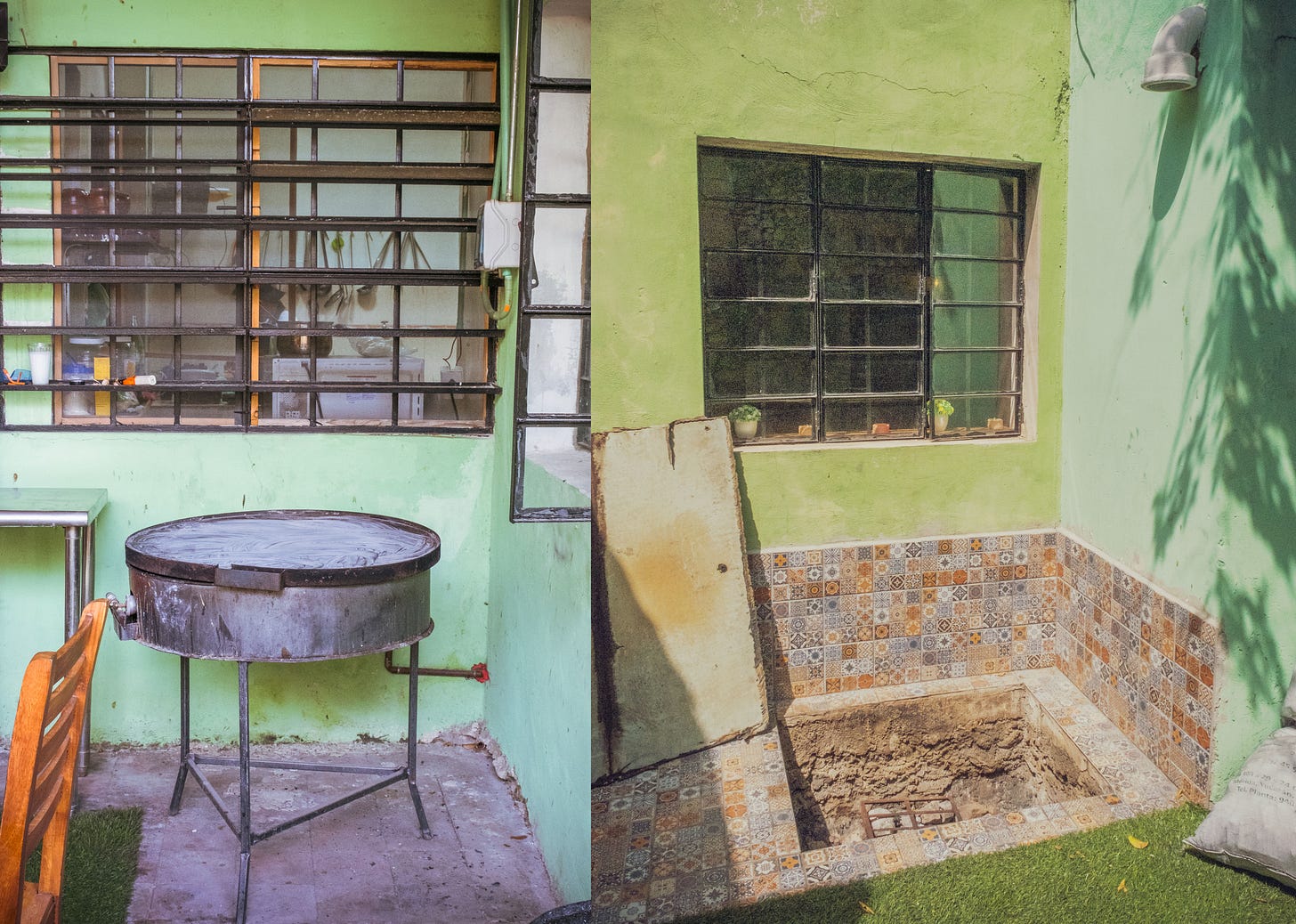Relleno Negro, Sleeper Hit of the Yucatán
Cochinita pibíl may be the dish that initially drew me to the Yucatán, but relleno negro has me booking a return trip to this capital city
The serving of relleno negro set before us at Taqueria La Lupita, a popular stall in Mérida’s Mercado de Santiago, did not look promising: shredded hunks of meat partially covered in an ashy paste, topped with sliced hard-boiled egg.
But as my mother always cautioned, appearances can be deceiving.
The first bite unleashed a flavor explosion that far surpassed the cochinita pibil’s sour orange and achiote marinade we had enjoyed earlier. I tapped into the recesses of my culinary memory to comprehend what I was eating.
My partner and I shouted at one another:
“Cumin seed?”
“Garlic?”
“Clove? Mexican oregano?”
“Yes…yes.”
“ Ahh, f***, that smoke…wow.”
The relleno negro was so unlike anything we had ever tasted or seen that it was hard to make out each component.
I also luxuriated in the tenderness of the shredded meat. Was this really turkey, as the menu indicated? The server confirmed it was, though this being the Yucatán, the dish also contained pork in the form of garlic-laced morsels of ground meat.
Foolishly, I had nearly finished my taco before sticking a pinkie into the accompanying thimble of sooty liquid. What a mistake. This elixir turned out to be an emulsification of the smoky spice paste in a fat-slicked broth.
I eagerly poured the entirety of this liquid gold over my last remaining bite. Pure magic.
–
Still under the spell of relleno negro, we ordered it the following day at Ch’e’en Cocina Yucateca, a Mérida restaurant with outstanding, homestyle Yucatecan dishes.
This relleno negro barely resembled what we ate at La Lupita. It was the culinary equivalent of primordial soup—a bowlful of pitch black liquid with chunks of braised meat and a whole hard-boiled egg bobbing on the surface.
While we waited for fresh tortillas to arrive I plunged my spoon into the stew. As I pulled it to my mouth for that first taste, the viscous mixture coated the back of my spoon like a slick of motor oil on a dipstick.
It smelled less of garlic and oregano than La Lupita’s version, with a more nuanced spice profile. It was also smokier and quite spicy.
In addition to chunks of poultry (this time, chicken), the bowl contained half a pork meatball, stained black with charred spices and stuffed with bits of hard-boiled egg. Our affable server, Edgar, jokingly referred to this softball-sized orb as an albondigón (a giant meatball), but explained it is more commonly known by its Mayan name buut’.
[In traditional preparations the buut’ (which means “filling”) is stuffed inside a whole turkey before being lowered into a pot of the simmering stew; at Ch’e’en, which is typical of many restaurants in Mérida, the meatball is cooked alongside the poultry.]
When Edgar returned to our table with the most sublime handmade tortillas I have ever tasted (bursting with corn flavor, smoke-kissed and having the perfect chew), he rattled off a list of ingredients that recalled our back-and-forth a day earlier at La Lupita: yes there was cumin, clove, garlic and oregano in the seasoning, but also black pepper, achiote, onion, corn tortilla, epazote, sour orange, tomato and multiple types of chiles.
When we questioned what turns relleno negro such a deep black, he took us outside to the comal (a circular griddle) where the spices, alliums, chiles and tortillas are toasted until carbonized. He also pointed out the píib, the earth oven where the dish is cooked overnight. It’s this traditional method of cooking that permeates the dish with its smoky perfume.
Back at our table, we reflected on the dish we had just devoured. At once earthy and intricately spiced with an intoxicating aroma of chiles and char, Ch’e’en’s relleno negro was a gastronomic marvel.
–
Wander around Mérida and you will notice that relleno negro appears on every reputable Yucatecan menu in town, from humble market stands and cocinas económicas to temples of culinary innovation.
It surprised us that a dish with a shopping list rivaling that of a Thanksgiving feast could be served seven days a week. It wasn’t until we stepped into a market that we understood how this was possible. The answer: recado negro.
Spice stalls in the Yucatán are a riot of colors, similar to those found in Moroccan souks. In addition to offering individual spices and herbs, they sell seasoning blends of Maya origin called recados (xa’ak in Mayan). In their most basic form, recados are powdered mixtures of toasted, ground spices and herbs; often they are transformed into glossy pastes with the addition of vinegar.

Recado negro is just one of many recados, so along with the black version one will see recado rojo, stained vibrant ochre from ground achiote; army green recado verde made from milled pepitas; and brownish-green recados para escabeche that combine peppercorns, oregano, cloves, allspice and bay leaves to form the base of a dish called escabeche oriental. The list goes on and on.
To prepare relleno negro, you simply add sour orange juice to recado negro in powder or paste form and incorporate any additional ingredients to add your own touch to the finished dish.
Whereas some cooks and select restaurants such as Ch’e’en still make their own recados from scratch, many Yucatecos rely on these concentrated mixtures—the ultimate convenience food—to bring relleno negro to life.
We very much wanted to bring recado negro back to Chicago, however, due to murky TSA regulations (is a paste considered a liquid? would something resembling gun powder raise a red flag?) we opted not to take our chances.
With so many variations on this spectacular dish available in Mérida and throughout the Yucatán Peninsula, we figured why not book a return trip and start sampling them all?
All photos by Jared Wheeler









I love relleno negro.